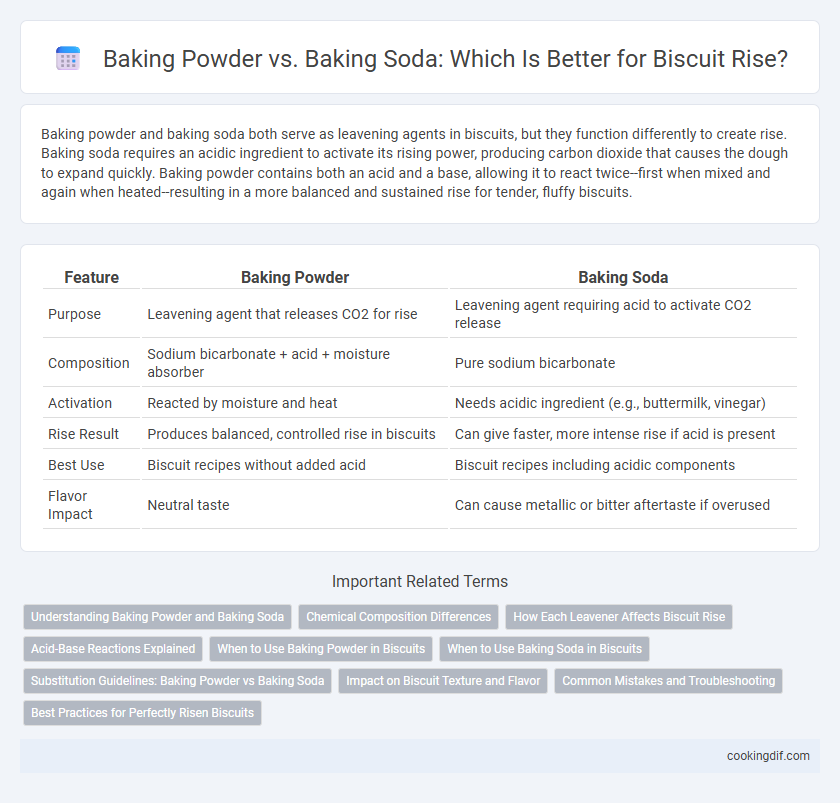Baking powder and baking soda both serve as leavening agents in biscuits, but they function differently to create rise. Baking soda requires an acidic ingredient to activate its rising power, producing carbon dioxide that causes the dough to expand quickly. Baking powder contains both an acid and a base, allowing it to react twice--first when mixed and again when heated--resulting in a more balanced and sustained rise for tender, fluffy biscuits.
Table of Comparison
| Feature | Baking Powder | Baking Soda |
|---|---|---|
| Purpose | Leavening agent that releases CO2 for rise | Leavening agent requiring acid to activate CO2 release |
| Composition | Sodium bicarbonate + acid + moisture absorber | Pure sodium bicarbonate |
| Activation | Reacted by moisture and heat | Needs acidic ingredient (e.g., buttermilk, vinegar) |
| Rise Result | Produces balanced, controlled rise in biscuits | Can give faster, more intense rise if acid is present |
| Best Use | Biscuit recipes without added acid | Biscuit recipes including acidic components |
| Flavor Impact | Neutral taste | Can cause metallic or bitter aftertaste if overused |
Understanding Baking Powder and Baking Soda
Baking powder contains both an acid and a base, enabling it to release carbon dioxide gas during baking for effective leavening without additional acidic ingredients. Baking soda, or sodium bicarbonate, requires an acidic component like lemon juice or yogurt to activate and produce the rise in baked goods. Understanding the chemical composition and activation process of baking powder versus baking soda is essential for achieving the desired texture and volume in biscuits.
Chemical Composition Differences
Baking powder contains both an acid (usually cream of tartar) and a base (sodium bicarbonate), allowing it to release carbon dioxide gas when moistened and heated, which helps biscuits rise evenly. Baking soda is pure sodium bicarbonate and requires an acidic ingredient in the recipe, such as buttermilk or yogurt, to activate its leavening properties. The chemical composition difference means baking powder is a complete leavening agent, while baking soda depends on external acids to produce the necessary gas for biscuit rise.
How Each Leavener Affects Biscuit Rise
Baking powder and baking soda both act as chemical leaveners but influence biscuit rise differently due to their composition and reaction process. Baking powder contains both an acid and a base, producing carbon dioxide gas through a double-acting reaction that creates consistent, sustained rise, resulting in light and fluffy biscuits. Baking soda requires an acidic ingredient, such as buttermilk, to activate, generating a rapid release of gas that produces a quicker rise, yielding biscuits with a tender crumb and slightly crisp exterior.
Acid-Base Reactions Explained
Baking powder contains both an acid and a base, triggering a balanced acid-base reaction that produces carbon dioxide gas for effective biscuit rise. Baking soda requires an external acidic ingredient like buttermilk to activate its base, ensuring proper leavening through acid-base neutralization. Understanding these chemical reactions helps bakers optimize biscuit texture and volume by selecting the appropriate leavening agent.
When to Use Baking Powder in Biscuits
Baking powder is a leavening agent that contains both an acid and a base, making it ideal for recipes like biscuits that do not have acidic ingredients. It ensures a consistent rise by releasing carbon dioxide gas when exposed to moisture and heat, creating light and fluffy textures. Use baking powder in biscuits when the recipe lacks acidic components such as buttermilk or yogurt to achieve optimal leavening and tender crumb.
When to Use Baking Soda in Biscuits
Baking soda is ideal for biscuits containing acidic ingredients such as buttermilk, yogurt, or vinegar, as it reacts immediately to produce carbon dioxide, resulting in a quick rise and tender crumb. Use baking soda when the recipe balances acidity to avoid soapy taste or greenish tint in the dough. For biscuits requiring a fast rise and soft texture, baking soda activates during baking to create lightness and fluffiness.
Substitution Guidelines: Baking Powder vs Baking Soda
Baking powder contains both an acid and a base, making it a complete leavening agent, while baking soda requires an acidic ingredient to activate its rising properties. When substituting baking powder for baking soda, use about three times the amount of baking powder to achieve similar rise since baking powder is less concentrated. For replacing baking powder with baking soda, add an acidic ingredient such as cream of tartar or lemon juice to balance the alkaline nature and ensure proper leavening.
Impact on Biscuit Texture and Flavor
Baking powder produces a tender, flaky biscuit texture due to its balanced acid-base composition, which releases carbon dioxide slowly during baking. Baking soda requires an acidic ingredient to activate and can create a slightly denser biscuit with a subtle metallic aftertaste if not properly balanced. The choice between baking powder and baking soda directly affects biscuit rise, crumb softness, and overall flavor profile.
Common Mistakes and Troubleshooting
Using baking powder instead of baking soda, or vice versa, often leads to improper rising in biscuits due to their differing chemical properties--baking powder contains both acid and base, activating with moisture and heat, while baking soda requires an acidic ingredient to trigger rise. A common mistake is not adjusting the recipe's acid level when substituting one for the other, resulting in dense or flat biscuits. Troubleshooting involves ensuring correct leavening agents are used in proper amounts and pairing baking soda with acidic components like buttermilk or yogurt to achieve optimal biscuit texture and lift.
Best Practices for Perfectly Risen Biscuits
Baking powder contains both an acid and a base, providing a balanced leavening reaction that ensures perfectly risen biscuits with a tender crumb. Baking soda requires an acidic ingredient, such as buttermilk, to activate, making it crucial to measure and combine ingredients precisely for optimal rise. Using the correct leavening agent and fresh baking powder or soda guarantees light, fluffy biscuits with ideal texture and height.
Baking Powder vs Baking Soda for rise Infographic

 cookingdif.com
cookingdif.com